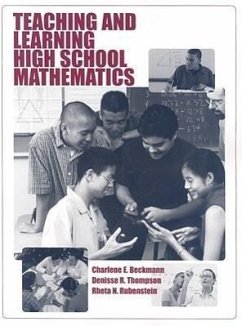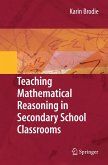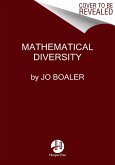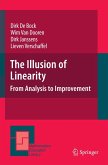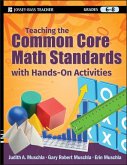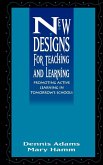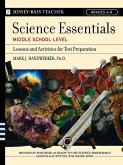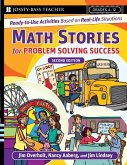Charlene E Beckmann, Denisse R Thompson, Rheta N Rubenstein
Teaching and Learning High School Mathematics
Charlene E Beckmann, Denisse R Thompson, Rheta N Rubenstein
Teaching and Learning High School Mathematics
- Broschiertes Buch
- Merkliste
- Auf die Merkliste
- Bewerten Bewerten
- Teilen
- Produkt teilen
- Produkterinnerung
- Produkterinnerung
A perfect resource for high school mathematics teachers, this book helps them develop or refine their own teaching philosophy. They'll learn how to create a supportive classroom environment in which their students think together, take intellectual risks, and debate ideas. They'll gain a better understanding about the importance of cooperative learning strategies through immersion. And they'll engage in logic and reasoning. Puzzles and activities are presented to bring the material to life as well. All of this will help high school mathematics bring the excitement of the subject into the classroom.…mehr
Andere Kunden interessierten sich auch für
![Teaching Mathematical Reasoning in Secondary School Classrooms Teaching Mathematical Reasoning in Secondary School Classrooms]() Karin BrodieTeaching Mathematical Reasoning in Secondary School Classrooms37,99 €
Karin BrodieTeaching Mathematical Reasoning in Secondary School Classrooms37,99 €![Math-Ish Math-Ish]() Jo BoalerMath-Ish21,99 €
Jo BoalerMath-Ish21,99 €![The Illusion of Linearity The Illusion of Linearity]() Dirk De BockThe Illusion of Linearity125,99 €
Dirk De BockThe Illusion of Linearity125,99 €![Teaching the Common Core Math Standards with Hands-On Activities, Grades 6-8 Teaching the Common Core Math Standards with Hands-On Activities, Grades 6-8]() Judith A MuschlaTeaching the Common Core Math Standards with Hands-On Activities, Grades 6-829,99 €
Judith A MuschlaTeaching the Common Core Math Standards with Hands-On Activities, Grades 6-829,99 €![New Designs Teaching Learning New Designs Teaching Learning]() Dennis AdamsNew Designs Teaching Learning60,99 €
Dennis AdamsNew Designs Teaching Learning60,99 €![Science Essentials, Middle School Level Science Essentials, Middle School Level]() Mark J HandwerkerScience Essentials, Middle School Level31,99 €
Mark J HandwerkerScience Essentials, Middle School Level31,99 €![Math Stories for Problem Solving Success Math Stories for Problem Solving Success]() James L OverholtMath Stories for Problem Solving Success29,99 €
James L OverholtMath Stories for Problem Solving Success29,99 €-
-
-
A perfect resource for high school mathematics teachers, this book helps them develop or refine their own teaching philosophy. They'll learn how to create a supportive classroom environment in which their students think together, take intellectual risks, and debate ideas. They'll gain a better understanding about the importance of cooperative learning strategies through immersion. And they'll engage in logic and reasoning. Puzzles and activities are presented to bring the material to life as well. All of this will help high school mathematics bring the excitement of the subject into the classroom.
Hinweis: Dieser Artikel kann nur an eine deutsche Lieferadresse ausgeliefert werden.
Hinweis: Dieser Artikel kann nur an eine deutsche Lieferadresse ausgeliefert werden.
Produktdetails
- Produktdetails
- Verlag: Wiley
- Seitenzahl: 560
- Erscheinungstermin: 1. November 2009
- Englisch
- Abmessung: 279mm x 216mm x 19mm
- Gewicht: 1016g
- ISBN-13: 9780470454503
- ISBN-10: 0470454504
- Artikelnr.: 27065449
- Herstellerkennzeichnung
- Produktsicherheitsverantwortliche/r
- Europaallee 1
- 36244 Bad Hersfeld
- gpsr@libri.de
- Verlag: Wiley
- Seitenzahl: 560
- Erscheinungstermin: 1. November 2009
- Englisch
- Abmessung: 279mm x 216mm x 19mm
- Gewicht: 1016g
- ISBN-13: 9780470454503
- ISBN-10: 0470454504
- Artikelnr.: 27065449
- Herstellerkennzeichnung
- Produktsicherheitsverantwortliche/r
- Europaallee 1
- 36244 Bad Hersfeld
- gpsr@libri.de
Dr. Charlene Beckmann is a professor of Mathematics at Grand Valley State University. Her research interests include: assessment, cooperative learning, real life uses of mathematics, functions, games, literature and mathematics, technology, how conceptual understanding builds their ability to understand and write proofs.
Course Introduction
Mathematics Education: Where Do I Stand?
Unit One. Encouraging Communication in Mathematics Classrooms
(Mathematics Strand: Logic and Reasoning)
Unit One Team-Builder: Carpet Square Maze
Preparing to Observe Mathematics Classrooms: Focus on Equity
Listening to Students Reason About Mathematics
1.1 Developing Questioning Strategies: Conjecturing and Reasoning
1.2 Exploring Mathematical Concepts Cooperatively: Reasoning with
Conditional Statements
1.3 Using Representations to Investigate Mathematics: Reasoning with
Conjunctions, Disjunctions, and Negations
1.4 Learning from Students: Valid and Invalid Arguments
1.5 Summarizing Classroom Observations and Listening to Students: Focus on
Equity Synthesizing Unit One
Unit One Investigation: Carpet Square Mazes
Unit Two. High School Students and How They Learn
(Mathematics Strands: Geometry and Measurement)
Unit Two Team-Builder: Transformed Snowflakes
Preparing to Observe Mathematics Classrooms: Focus on Learning
Listening to Students Reason About Geometry
Understanding Geometry Learning: Coordinate Geometry
2.2 Building Conceptual Understanding: Congruence and Similarity
2.3 Learning Mathematics through Multiple Perspectives: Quadrilaterals and
Constructions
2.4 Using Physical Tools and Technology: Circles
2.5 Tasks with High Cognitive Demand: Measurement in the Plane and in Space
2.6 Doing Mathematics: Axiomatic Systems
2.7 Summarizing Classroom Observations and Listening to Students
Synthesizing Unit Two
Unit Two Investigation: Transformations
Unit Three. Planning for Instruction
(Mathematics Strands: Algebra and Functions)
Unit Three Team-Builder: Find Your Function Family
Preparing to Observe Mathematics Classrooms: Focus on Curriculum and
Technology
Listening to Students Reason about Functions
3.1 Building on Students' Knowledge and Experiences: Understanding
Variables and Linear Functions
3.2 Thinking about Learning Outcomes: Exponential Functions
3.3 Active Learning: Modeling Data Through Experiments
3.4 Teaching with Technology: Geometry of Functions
3.5 Increasing Challenge or Accessibility of Problems: Polynomial Functions
3.6 Accommodating Different Learning Styles: Rational Functions
3.7 Summarizing Observations and Listening to Students
Synthesizing Unit Three
Unit Three Investigation: Families of Functions
Unit Four. Lesson Planning
(Mathematics Strands: Data Analysis and Probability)
Unit Four Team-Builder: A Dream Team in Hockey
Preparing to Observe Mathematics Classrooms: Focus on Teaching
Listening to Students Reason about Data Analysis and Probability
4.1 Planning a Lesson Launch and Explore: Data Analysis
4.2 Planning a Lesson Share and Summarize: Probability
4.3 Blending Direct Instruction into a Lesson: Variability and
Distributions
4.4 Planning for Alternative Schedules: Statistical Decision Making
4.5 Summarizing Observations and Listening to Students
Synthesizing Unit Four
Unit Four Investigation: Build Your Own Dream Team
Unit Five. Assessment of Students' Learning
(Mathematics Strand: Precalculus)
Unit Five Team-Builder: Conic Conundrum
Preparing to Observe Mathematics Classrooms:Focus on Assessment
Listening to Students Reason about Precalculus
5.1 Daily Assessments: Limits
5.2 Rubrics: Rates of Change
5.3 Designing and Aligning Tests with Instruction
5.4 Alternative Assessments: Accumulations
5.5 Summarizing Observations and Listening to Students Synthesizing Unit
Five
Unit Five Investigation: Conic Sections
Unit Six. Collaborating with Educational Partners
Listening to Educational Partners about Issues in Mathematics Education
6.1 Evaluating Curriculum Materials
6.2 Coordinating Curricula Beyond the Classroom
6.3 Continued Professional Development
6.4 Summarizing Interviews on Educational Issues
Synthesizing Unit Six
Mathematics Education: Where Do I Stand?
Unit One. Encouraging Communication in Mathematics Classrooms
(Mathematics Strand: Logic and Reasoning)
Unit One Team-Builder: Carpet Square Maze
Preparing to Observe Mathematics Classrooms: Focus on Equity
Listening to Students Reason About Mathematics
1.1 Developing Questioning Strategies: Conjecturing and Reasoning
1.2 Exploring Mathematical Concepts Cooperatively: Reasoning with
Conditional Statements
1.3 Using Representations to Investigate Mathematics: Reasoning with
Conjunctions, Disjunctions, and Negations
1.4 Learning from Students: Valid and Invalid Arguments
1.5 Summarizing Classroom Observations and Listening to Students: Focus on
Equity Synthesizing Unit One
Unit One Investigation: Carpet Square Mazes
Unit Two. High School Students and How They Learn
(Mathematics Strands: Geometry and Measurement)
Unit Two Team-Builder: Transformed Snowflakes
Preparing to Observe Mathematics Classrooms: Focus on Learning
Listening to Students Reason About Geometry
Understanding Geometry Learning: Coordinate Geometry
2.2 Building Conceptual Understanding: Congruence and Similarity
2.3 Learning Mathematics through Multiple Perspectives: Quadrilaterals and
Constructions
2.4 Using Physical Tools and Technology: Circles
2.5 Tasks with High Cognitive Demand: Measurement in the Plane and in Space
2.6 Doing Mathematics: Axiomatic Systems
2.7 Summarizing Classroom Observations and Listening to Students
Synthesizing Unit Two
Unit Two Investigation: Transformations
Unit Three. Planning for Instruction
(Mathematics Strands: Algebra and Functions)
Unit Three Team-Builder: Find Your Function Family
Preparing to Observe Mathematics Classrooms: Focus on Curriculum and
Technology
Listening to Students Reason about Functions
3.1 Building on Students' Knowledge and Experiences: Understanding
Variables and Linear Functions
3.2 Thinking about Learning Outcomes: Exponential Functions
3.3 Active Learning: Modeling Data Through Experiments
3.4 Teaching with Technology: Geometry of Functions
3.5 Increasing Challenge or Accessibility of Problems: Polynomial Functions
3.6 Accommodating Different Learning Styles: Rational Functions
3.7 Summarizing Observations and Listening to Students
Synthesizing Unit Three
Unit Three Investigation: Families of Functions
Unit Four. Lesson Planning
(Mathematics Strands: Data Analysis and Probability)
Unit Four Team-Builder: A Dream Team in Hockey
Preparing to Observe Mathematics Classrooms: Focus on Teaching
Listening to Students Reason about Data Analysis and Probability
4.1 Planning a Lesson Launch and Explore: Data Analysis
4.2 Planning a Lesson Share and Summarize: Probability
4.3 Blending Direct Instruction into a Lesson: Variability and
Distributions
4.4 Planning for Alternative Schedules: Statistical Decision Making
4.5 Summarizing Observations and Listening to Students
Synthesizing Unit Four
Unit Four Investigation: Build Your Own Dream Team
Unit Five. Assessment of Students' Learning
(Mathematics Strand: Precalculus)
Unit Five Team-Builder: Conic Conundrum
Preparing to Observe Mathematics Classrooms:Focus on Assessment
Listening to Students Reason about Precalculus
5.1 Daily Assessments: Limits
5.2 Rubrics: Rates of Change
5.3 Designing and Aligning Tests with Instruction
5.4 Alternative Assessments: Accumulations
5.5 Summarizing Observations and Listening to Students Synthesizing Unit
Five
Unit Five Investigation: Conic Sections
Unit Six. Collaborating with Educational Partners
Listening to Educational Partners about Issues in Mathematics Education
6.1 Evaluating Curriculum Materials
6.2 Coordinating Curricula Beyond the Classroom
6.3 Continued Professional Development
6.4 Summarizing Interviews on Educational Issues
Synthesizing Unit Six
Course Introduction
Mathematics Education: Where Do I Stand?
Unit One. Encouraging Communication in Mathematics Classrooms
(Mathematics Strand: Logic and Reasoning)
Unit One Team-Builder: Carpet Square Maze
Preparing to Observe Mathematics Classrooms: Focus on Equity
Listening to Students Reason About Mathematics
1.1 Developing Questioning Strategies: Conjecturing and Reasoning
1.2 Exploring Mathematical Concepts Cooperatively: Reasoning with
Conditional Statements
1.3 Using Representations to Investigate Mathematics: Reasoning with
Conjunctions, Disjunctions, and Negations
1.4 Learning from Students: Valid and Invalid Arguments
1.5 Summarizing Classroom Observations and Listening to Students: Focus on
Equity Synthesizing Unit One
Unit One Investigation: Carpet Square Mazes
Unit Two. High School Students and How They Learn
(Mathematics Strands: Geometry and Measurement)
Unit Two Team-Builder: Transformed Snowflakes
Preparing to Observe Mathematics Classrooms: Focus on Learning
Listening to Students Reason About Geometry
Understanding Geometry Learning: Coordinate Geometry
2.2 Building Conceptual Understanding: Congruence and Similarity
2.3 Learning Mathematics through Multiple Perspectives: Quadrilaterals and
Constructions
2.4 Using Physical Tools and Technology: Circles
2.5 Tasks with High Cognitive Demand: Measurement in the Plane and in Space
2.6 Doing Mathematics: Axiomatic Systems
2.7 Summarizing Classroom Observations and Listening to Students
Synthesizing Unit Two
Unit Two Investigation: Transformations
Unit Three. Planning for Instruction
(Mathematics Strands: Algebra and Functions)
Unit Three Team-Builder: Find Your Function Family
Preparing to Observe Mathematics Classrooms: Focus on Curriculum and
Technology
Listening to Students Reason about Functions
3.1 Building on Students' Knowledge and Experiences: Understanding
Variables and Linear Functions
3.2 Thinking about Learning Outcomes: Exponential Functions
3.3 Active Learning: Modeling Data Through Experiments
3.4 Teaching with Technology: Geometry of Functions
3.5 Increasing Challenge or Accessibility of Problems: Polynomial Functions
3.6 Accommodating Different Learning Styles: Rational Functions
3.7 Summarizing Observations and Listening to Students
Synthesizing Unit Three
Unit Three Investigation: Families of Functions
Unit Four. Lesson Planning
(Mathematics Strands: Data Analysis and Probability)
Unit Four Team-Builder: A Dream Team in Hockey
Preparing to Observe Mathematics Classrooms: Focus on Teaching
Listening to Students Reason about Data Analysis and Probability
4.1 Planning a Lesson Launch and Explore: Data Analysis
4.2 Planning a Lesson Share and Summarize: Probability
4.3 Blending Direct Instruction into a Lesson: Variability and
Distributions
4.4 Planning for Alternative Schedules: Statistical Decision Making
4.5 Summarizing Observations and Listening to Students
Synthesizing Unit Four
Unit Four Investigation: Build Your Own Dream Team
Unit Five. Assessment of Students' Learning
(Mathematics Strand: Precalculus)
Unit Five Team-Builder: Conic Conundrum
Preparing to Observe Mathematics Classrooms:Focus on Assessment
Listening to Students Reason about Precalculus
5.1 Daily Assessments: Limits
5.2 Rubrics: Rates of Change
5.3 Designing and Aligning Tests with Instruction
5.4 Alternative Assessments: Accumulations
5.5 Summarizing Observations and Listening to Students Synthesizing Unit
Five
Unit Five Investigation: Conic Sections
Unit Six. Collaborating with Educational Partners
Listening to Educational Partners about Issues in Mathematics Education
6.1 Evaluating Curriculum Materials
6.2 Coordinating Curricula Beyond the Classroom
6.3 Continued Professional Development
6.4 Summarizing Interviews on Educational Issues
Synthesizing Unit Six
Mathematics Education: Where Do I Stand?
Unit One. Encouraging Communication in Mathematics Classrooms
(Mathematics Strand: Logic and Reasoning)
Unit One Team-Builder: Carpet Square Maze
Preparing to Observe Mathematics Classrooms: Focus on Equity
Listening to Students Reason About Mathematics
1.1 Developing Questioning Strategies: Conjecturing and Reasoning
1.2 Exploring Mathematical Concepts Cooperatively: Reasoning with
Conditional Statements
1.3 Using Representations to Investigate Mathematics: Reasoning with
Conjunctions, Disjunctions, and Negations
1.4 Learning from Students: Valid and Invalid Arguments
1.5 Summarizing Classroom Observations and Listening to Students: Focus on
Equity Synthesizing Unit One
Unit One Investigation: Carpet Square Mazes
Unit Two. High School Students and How They Learn
(Mathematics Strands: Geometry and Measurement)
Unit Two Team-Builder: Transformed Snowflakes
Preparing to Observe Mathematics Classrooms: Focus on Learning
Listening to Students Reason About Geometry
Understanding Geometry Learning: Coordinate Geometry
2.2 Building Conceptual Understanding: Congruence and Similarity
2.3 Learning Mathematics through Multiple Perspectives: Quadrilaterals and
Constructions
2.4 Using Physical Tools and Technology: Circles
2.5 Tasks with High Cognitive Demand: Measurement in the Plane and in Space
2.6 Doing Mathematics: Axiomatic Systems
2.7 Summarizing Classroom Observations and Listening to Students
Synthesizing Unit Two
Unit Two Investigation: Transformations
Unit Three. Planning for Instruction
(Mathematics Strands: Algebra and Functions)
Unit Three Team-Builder: Find Your Function Family
Preparing to Observe Mathematics Classrooms: Focus on Curriculum and
Technology
Listening to Students Reason about Functions
3.1 Building on Students' Knowledge and Experiences: Understanding
Variables and Linear Functions
3.2 Thinking about Learning Outcomes: Exponential Functions
3.3 Active Learning: Modeling Data Through Experiments
3.4 Teaching with Technology: Geometry of Functions
3.5 Increasing Challenge or Accessibility of Problems: Polynomial Functions
3.6 Accommodating Different Learning Styles: Rational Functions
3.7 Summarizing Observations and Listening to Students
Synthesizing Unit Three
Unit Three Investigation: Families of Functions
Unit Four. Lesson Planning
(Mathematics Strands: Data Analysis and Probability)
Unit Four Team-Builder: A Dream Team in Hockey
Preparing to Observe Mathematics Classrooms: Focus on Teaching
Listening to Students Reason about Data Analysis and Probability
4.1 Planning a Lesson Launch and Explore: Data Analysis
4.2 Planning a Lesson Share and Summarize: Probability
4.3 Blending Direct Instruction into a Lesson: Variability and
Distributions
4.4 Planning for Alternative Schedules: Statistical Decision Making
4.5 Summarizing Observations and Listening to Students
Synthesizing Unit Four
Unit Four Investigation: Build Your Own Dream Team
Unit Five. Assessment of Students' Learning
(Mathematics Strand: Precalculus)
Unit Five Team-Builder: Conic Conundrum
Preparing to Observe Mathematics Classrooms:Focus on Assessment
Listening to Students Reason about Precalculus
5.1 Daily Assessments: Limits
5.2 Rubrics: Rates of Change
5.3 Designing and Aligning Tests with Instruction
5.4 Alternative Assessments: Accumulations
5.5 Summarizing Observations and Listening to Students Synthesizing Unit
Five
Unit Five Investigation: Conic Sections
Unit Six. Collaborating with Educational Partners
Listening to Educational Partners about Issues in Mathematics Education
6.1 Evaluating Curriculum Materials
6.2 Coordinating Curricula Beyond the Classroom
6.3 Continued Professional Development
6.4 Summarizing Interviews on Educational Issues
Synthesizing Unit Six

